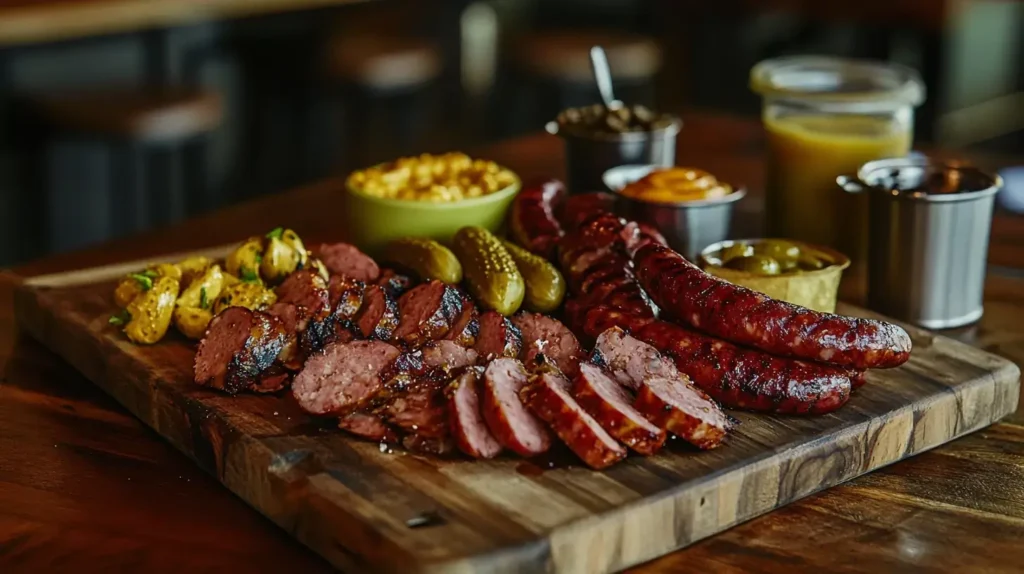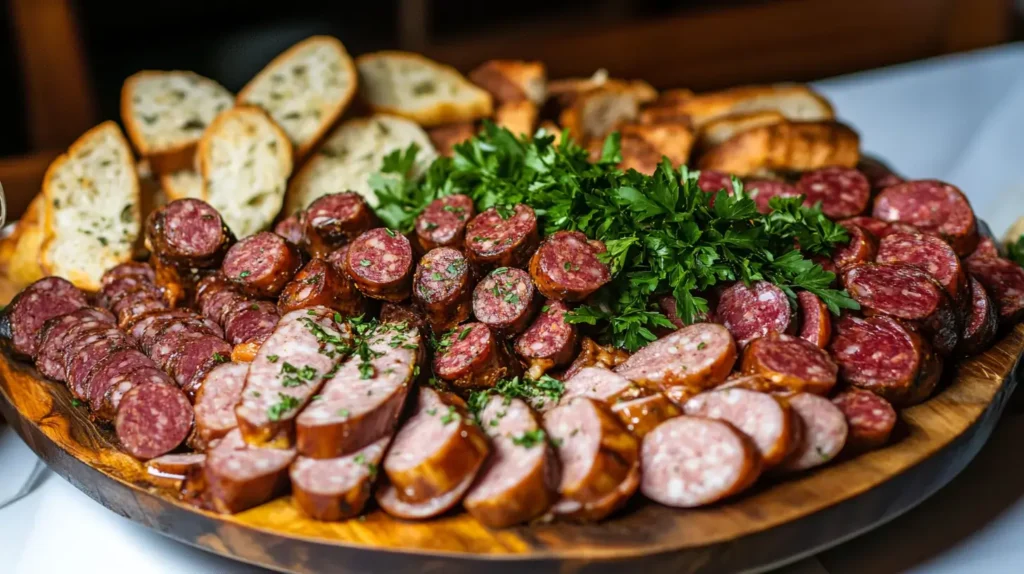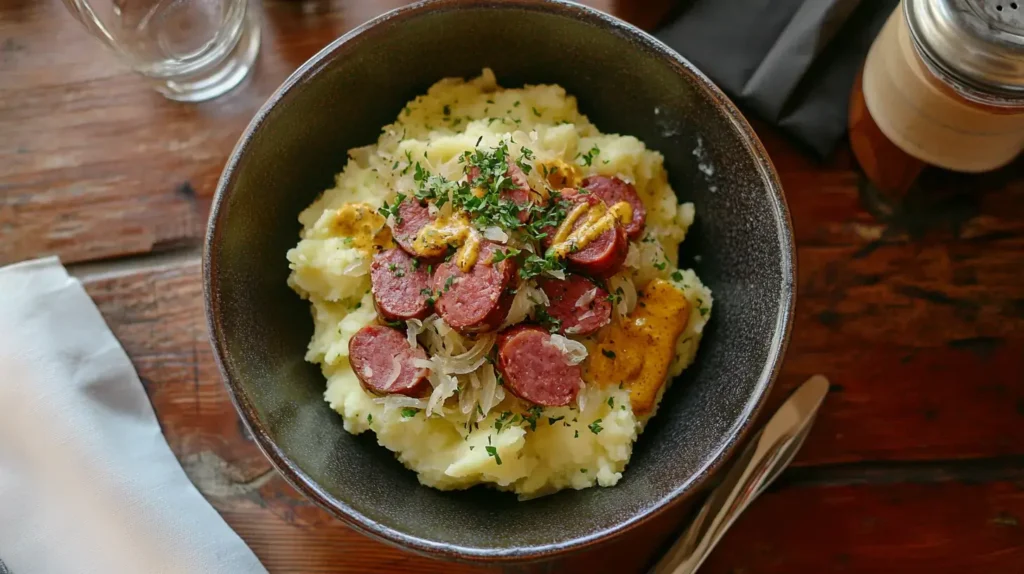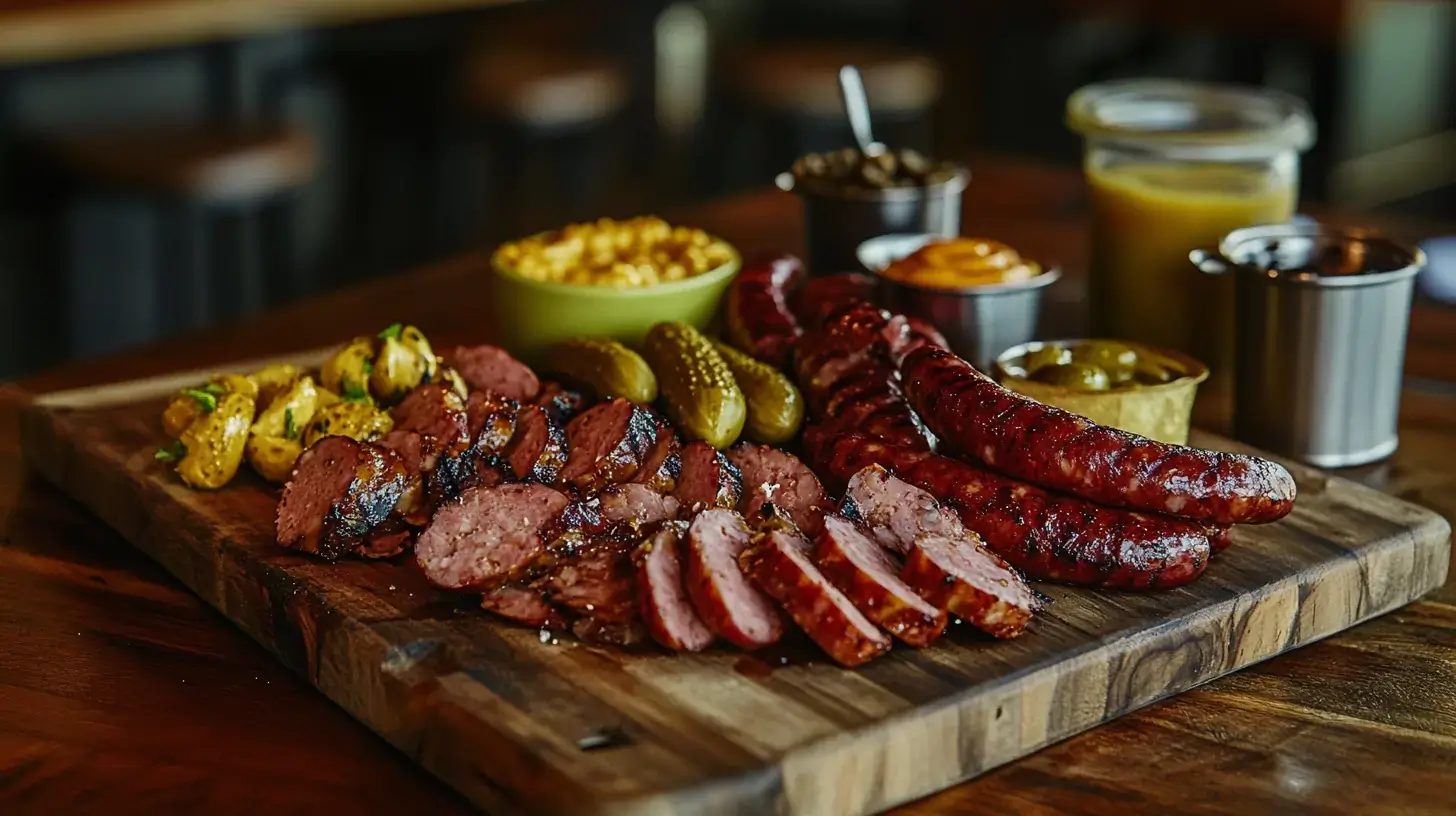
Introduction
When you think of tasty, flavorful meats, both kielbasa and sausage might come to mind. These two names are often used to mean the same thing, but they actually stand for different food traditions and flavors. While kielbasa is a type of sausage, its preparation, ingredients, and role in Polish culture make it different from other types of sausage.
In this article, we’ll look at what makes kielbasa special, its deep roots in Polish cooking, and how it’s different from sausages around the world. By the end, you’ll see why kielbasa has a special place in food traditions and, most importantly, how it stands out.
What Is Kielbasa?
Kielbasa, pronounced keel-BAH-sah, is the Polish word for sausage, but it specifically refers to a variety of traditional Polish sausages. Unlike generic sausages, kielbasa is deeply rooted in Polish culture and is often associated with celebratory meals, family gatherings, and traditional recipes passed down through generations.
Origin and Cultural Significance
- Cultural Roots: Kielbasa has been a staple in Polish cuisine for centuries. It is often enjoyed during holidays like Christmas and Easter, where it plays a central role in festive meals.
- Regional Variations: Poland offers numerous types of kielbasa, each with its unique flavor profile and preparation method. For instance, popular examples include smoked kielbasa (kielbasa wędzona), white kielbasa (kielbasa biała), and dry kielbasa (kielbasa sucha). Moreover, these varieties showcase the versatility and richness of Polish culinary traditions.
- Iconic Shape: One of the distinguishing features of kielbasa is its U-shape, which is created during the smoking process and makes it easily recognizable.
Ingredients
Traditional kielbasa is typically made from pork, though some varieties include a mix of pork and beef. The meat is seasoned with simple yet bold spices, such as:
- Garlic (a signature ingredient).
- Marjoram.
- Black pepper.
This simplicity gives kielbasa its distinctive, robust flavor, making it different from many other sausages that use a wide array of seasonings and fillers.
What Is Sausage?
Sausage is a versatile and widely consumed food with roots in nearly every culture worldwide. Unlike kielbasa, which is a specific type of sausage, the term “sausage” refers to a broad category of meat products that vary greatly in ingredients, preparation, and flavor profiles.
Definition of Sausage
Sausage is traditionally made by combining ground meat with seasonings, fat, and occasionally fillers like breadcrumbs or rice. The mixture is typically stuffed into casings made from animal intestines or synthetic materials. Additionally, depending on the type, sausages may be fresh, smoked, dried, or cooked, making them incredibly versatile in their preparation methods.
Types of Sausages Around the World
Sausages come in countless varieties, reflecting regional culinary traditions. Here are some notable examples:
- Chorizo (Spain and Mexico): A spicy, paprika-seasoned sausage often used in stews, tacos, or as a standalone snack.
- Bratwurst (Germany): A mild, herb-flavored sausage often grilled and served with mustard and sauerkraut.
- Andouille (France/USA): A smoked sausage with a bold, smoky flavor, commonly used in Cajun and Creole cooking.
- Italian Sausage (Italy): Available in sweet or spicy varieties, it’s a key ingredient in pasta dishes and pizzas.
Key Ingredients
Unlike kielbasa, which often adheres to a simpler seasoning profile, sausages vary widely in ingredients:
- Meats: Can include pork, beef, chicken, lamb, or even game meats like venison.
- Seasonings: Depending on the region, these may include garlic, fennel, sage, paprika, or cayenne pepper.
- Fillers: Some sausages incorporate grains, vegetables, or dairy products like cheese.
How Sausage Differs From Kielbasa
While sausage is a general term, kielbasa holds a specific identity with its Polish heritage and garlicky, smoky flavors. Sausage, on the other hand, acts as a catch-all term encompassing an enormous variety of styles, flavors, and traditions.
Key Differences Between Kielbasa and Sausage
Though kielbasa is technically a type of sausage, several distinct characteristics set it apart from the broader category. These differences stem from variations in ingredients, preparation methods, and cultural significance. Here’s a detailed breakdown:
Ingredients
- Kielbasa: Typically made from pork or a pork-beef blend, kielbasa is seasoned with garlic, marjoram, and black pepper. As a result, the ingredients are straightforward, yet they create a bold and simple flavor profile.
- Sausage: Ingredients vary widely depending on the type and region. For example, sausages can include pork, beef, chicken, lamb, or even plant-based proteins, which are then combined with seasonings like fennel, sage, paprika, or cayenne. In addition, fillers such as rice, breadcrumbs, or cheese are often added to enhance texture and flavor.
Shape and Appearance
- Kielbasa: Known for its distinctive U-shape, created during the traditional smoking process. It is typically thicker than most sausages and often comes in coiled loops.
- Sausage: Sausages come in many shapes, including links, patties, and ground forms. Their appearance can be straight, coiled, or encased in natural or synthetic casings.
Smoking and Cooking Process
- Kielbasa: Kielbasa is traditionally smoked, thereby giving it its rich, savory aroma and flavor. However, some varieties, like kielbasa biała (white sausage), are left unsmoked and cooked fresh, offering a lighter, milder taste.
- Sausage: The preparation varies widely sausages can be fresh, smoked, cured, dried, or pre-cooked. For example, bratwurst is often grilled, while salami is air-dried.
Flavor Profiles
- Kielbasa: Bold and garlicky, with a smoky undertone from the traditional smoking process. Its flavor is consistent across most varieties.
- Sausage: The flavor spectrum is much broader, ranging from mild and sweet (like breakfast sausages) to spicy and robust (like chorizo).
Summary of Differences
| Aspect | Kielbasa | Sausage |
|---|---|---|
| Ingredients | Pork or pork-beef with simple seasonings | Wide variety of meats and seasonings |
| Shape | U-shaped and thicker | Varies: links, patties, coiled, etc. |
| Preparation | Smoked or fresh | Fresh, smoked, cured, or dried |
| Flavor | Garlicky and smoky | Mild to spicy, depending on the type |
Types of Kielbasa
Kielbasa comes in many varieties, each with its own flavor, preparation, and cultural significance. While all kielbasa shares common traits like bold seasoning and hearty texture, regional and traditional methods give rise to unique types. Here are some of the most popular types of kielbasa:

Wiejska (Country Sausage)
- Description: One of the most iconic forms of kielbasa, this sausage is made from a blend of pork and veal, seasoned with garlic and marjoram.
- Preparation: Typically smoked, giving it a robust, savory flavor.
- Usage: Often served sliced as a cold appetizer or cooked in soups and stews.
Krakowska (Krakow Sausage)
- Description: A coarsely ground sausage that originated in Krakow, Poland. It’s firm, lean, and seasoned with black pepper and garlic.
- Preparation: Usually smoked and sometimes partially dried, giving it a dense, chewy texture.
- Usage: Commonly eaten cold, sliced thin for sandwiches or charcuterie boards.
Biała (White Sausage)
- Description: Unlike most other kielbasa, this variety is unsmoked and has a lighter flavor. It’s made with pork and beef, seasoned with garlic, salt, and marjoram.
- Preparation: Typically sold raw and must be cooked before eating. It is often boiled or simmered.
- Usage: A traditional dish for Easter, served with soups like żurek (sour rye soup).
Czosnkowa (Garlic Sausage)
- Description: A variation known for its extra garlic-forward flavor.
- Preparation: Smoked and cooked, making it ready to eat.
- Usage: Perfect for snacking, sandwiches, or pairing with cheeses.
Sucha (Dry Sausage)
- Description: A dried and cured version of kielbasa with a more intense flavor.
- Preparation: Made to be shelf-stable, often cured and aged over weeks.
- Usage: Sliced thin and served as a snack or appetizer, similar to salami.
Regional Variations and Specialty Types
- Podwawelska Kielbasa: A specialty sausage from the Wawel region, known for its delicate seasoning.
- Kabanosy: A slim, dry, and smoked variety of kielbasa often seasoned with caraway.
Each type of kielbasa reflects Poland’s rich culinary heritage and showcases the adaptability of this beloved sausage.
Culinary Uses of Kielbasa
Kielbasa’s bold flavor and versatility make it a favorite in many kitchens. Moreover, its distinctive garlic and smoky notes shine in a variety of traditional and modern dishes. For these reasons, here are some popular ways to enjoy kielbasa:

Traditional Polish Dishes
- Kielbasa and Sauerkraut:
A classic pairing where kielbasa is simmered with tangy sauerkraut, onions, and spices, creating a hearty, flavorful dish. - Żurek (Sour Rye Soup):
A traditional Easter soup featuring kielbasa biała (white sausage) with potatoes, hard-boiled eggs, and fermented rye flour. - Bigos (Hunter’s Stew):
A slow-cooked stew of kielbasa, sauerkraut, mushrooms, and various meats, often referred to as Poland’s national dish.
Grilled or Smoked
- Grilled Kielbasa:
Perfect for summer barbecues, kielbasa is grilled until the casings are crispy and caramelized, often served with mustard and bread. - Smoked Kielbasa Platters:
Sliced and served cold or warm alongside cheeses, pickles, and bread for an appetizer or light meal.
Modern Twists
- Kielbasa Pasta:
Toss sliced kielbasa with pasta, a creamy sauce, and vegetables for a quick, satisfying meal.
(Check out this recipe: Kielbasa Pasta: A Delicious and Satisfying Dish) - Kielbasa Skewers:
Alternate slices of kielbasa with vegetables on skewers for a smoky, grilled treat. - Breakfast Hash:
Combine kielbasa with diced potatoes, peppers, and onions for a hearty breakfast skillet.
Soups and Casseroles
- Bean and Kielbasa Soup:
A comforting mix of beans, smoked kielbasa, and hearty vegetables in a rich broth. - Kielbasa Casseroles:
Layered with potatoes, cheese, and cream, baked until bubbly and golden.
Kielbasa’s rich flavors make it a versatile ingredient that pairs well with a wide range of cuisines, from traditional Polish recipes to contemporary fusion dishes.
Culinary Uses of Sausages
Sausages are incredibly versatile and adapt well to various cuisines, occasions, and meal types. Whether served as the star ingredient or a flavorful addition, sausages bring a range of tastes and textures to the table.
Breakfast Dishes
- Sausage and Eggs:
A classic breakfast pairing, with sausage links or patties served alongside scrambled or fried eggs. - Sausage Gravy and Biscuits:
Crumbled sausage cooked in creamy gravy, poured over flaky biscuits—a Southern staple. - Breakfast Casseroles:
Layer sausages with eggs, cheese, and bread for a baked morning treat.
Grilled and Barbecued
- BBQ Sausages:
Sausages like bratwurst or Italian sausage are ideal for grilling, often served in buns with mustard or sauerkraut. - Sausage Kebabs:
Skewer sausages with vegetables for a smoky, grilled appetizer or main dish.
Pasta and Rice Dishes
- Sausage and Peppers Pasta:
Sliced sausages cooked with bell peppers, onions, and marinara sauce, tossed with pasta. - Jambalaya:
Andouille sausage adds a spicy, smoky kick to this Louisiana rice dish, along with shrimp and chicken. - Risottos:
Sausages, particularly Italian varieties, bring a savory depth to creamy risottos.
Soups and Stews
- Lentil Soup with Sausage:
Sausages add protein and a burst of flavor to hearty lentil soups. - Cassoulet:
A slow-cooked French stew with sausages, beans, and meats like duck or pork. - Sausage Chili:
Swap ground beef for sausage to create a spicier, richer chili.
Casseroles and Bakes
- Sausage and Potato Bake:
Combine sausage links with potatoes, onions, and cheese, baked until golden. - Stuffed Peppers:
Fill bell peppers with a mixture of sausage, rice, and tomato sauce, then bake.
Snacks and Appetizers
Sausage Rolls:
Puff pastry wrapped around sausage meat, baked until flaky and golden—great for parties or quick snacks.
- Cocktail Sausages:
Bite sized sausages coated in sweet and tangy sauces, popular at gatherings.
Sausages bring a wide variety of flavors and textures to countless recipes, making them a pantry favorite. For even more ideas, check out our Beef Sausage Recipes: Delicious Ways to Enjoy This Versatile Meat and discover creative ways to incorporate sausages into your meals.
Nutritional Comparison of Kielbasa and Sausage
Kielbasa and sausage differ not only in flavor and preparation but also in their nutritional profiles. Understanding these differences can help you make informed choices based on your dietary needs.
Calories
- Kielbasa: Typically higher in calories due to its fat content and smoking process. One 2-ounce serving contains about 180–200 calories.
- Sausage: The calorie count varies widely depending on the type. For example:
- Breakfast sausage (2 ounces): ~150–160 calories.
- Italian sausage (2 ounces): ~180 calories.
- Chicken or turkey sausage (2 ounces): ~100–120 calories.
Fat Content
- Kielbasa:
High in fat, contributing to its rich flavor and moist texture. It contains around 15–18 grams of fat per 2-ounce serving, with 6–7 grams being saturated fat. - Sausage:
Fat levels vary:- Pork sausage: ~13–16 grams per 2-ounce serving.
- Chicken or turkey sausage: ~6–8 grams per 2-ounce serving, making it a leaner option.
Sodium
Both kielbasa and sausage can be high in sodium due to seasoning and preservation methods:
- Kielbasa: ~500–700 mg of sodium per serving, especially in smoked varieties.
- Sausage: Sodium levels range from 300–600 mg per serving, depending on the type and brand.
Protein
Both kielbasa and sausages are excellent sources of protein:
- Kielbasa: Provides about 8–10 grams of protein per serving.
- Sausage: Protein content is similar, ranging from 8–12 grams per serving, with leaner options often offering slightly higher protein.
Additional Considerations
- Additives: Many commercial sausages and kielbasa contain preservatives, nitrates, or fillers. Opt for artisanal or organic options for fewer additives.
- Dietary Preferences:
- Kielbasa is a good choice for bold flavors and hearty dishes but may not suit low-fat or low-sodium diets.
- Sausages, on the other hand, offer more variety, with leaner options like chicken or turkey sausage that especially cater to health-conscious eaters.
Which Is Healthier?
It depends on the type and how it’s prepared:
- For a richer, indulgent option, kielbasa is a great choice.
- If you’re watching your fat or sodium intake, leaner sausages are a better fit.
Conclusion
Kielbasa and sausage may share similarities, but their differences lie in flavor, preparation, and cultural significance. Kielbasa, with its Polish roots, garlicky notes, and distinctive smoking process, stands apart as a bold and hearty choice. Sausages, on the other hand, offer incredible variety, from spicy chorizo to mild bratwurst, making them versatile for countless cuisines and dishes.
Whether you’re looking for the robust flavors of kielbasa or the diverse options of sausages, both are excellent additions to your culinary repertoire. The next time you’re choosing between the two, consider the dish you’re making and the flavor profile you’re after. Either way, you’re in for a delicious treat!

